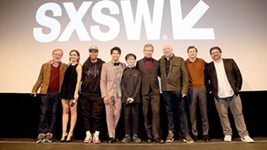Truth in Journalism: The Making of The Post
Reporters and researchers on Spielberg's journalistic epic
By Acacia Coronado, 2:00PM, Mon. Jan. 15, 2018

On a crisp spring evening in April 1971, as Renato Perez came home from his shift at The New York Times, he got a call from assistant foreign editor Gerald Gold. As of that week he was to report to the New York Hilton Hotel for a special, top secret project involving classified government documents on the Vietnam War – the Pentagon Papers.
Steven Spielberg’s film The Post (which went on wide release this weekend) takes audiences into the newsroom during one of the most significant Supreme Court cases involving the freedom of the press. In this film, Spielberg tells the story of how the Washington Post’s leaders risked everything to publish the Pentagon Papers (a complete and often critical overview of U.S. involvement in Vietnam and surrounding countries from 1945 to 1967, commissioned by the Department of Defense) after the government obtained a court injunction blocking the Times from printing the story.
Considering the repercussions this would have for a growing newspaper that had recently become a public company, publisher Katharine Graham must decide whether to risk her journalistic career and her family’s legacy to expose the truth.
Before the Post there was the Times
Perez, who then worked for the Times’ photo department, was released from his own section and instructed to do photo research for the project. He was told that nobody outside of those involved, not even his wife or editor, was to find out about what he was working on.
The Pentagon Papers (or, to give them their proper titles, United States – Vietnam Relations, 1945-1967: A Study Prepared by the Department of Defense), had been given to the Times by former Marine and State Department researcher Daniel Ellsberg. The documents were then given to Perez to read and analyze in one of the nine rooms rented out by Gold at the Hilton Hotel to be used by the researchers. Perez said once he realized the content of the document, he thought it was a ticking time bomb and the imperative secrecy to the point of paranoia made all the more sense to him. “It was a real production, but we were talking about a serious deal,” Perez said.

For his extensive search he used Times, Associated Press, and Pictorial Parade photo archives, among others. He would then collect the pictures, run them to the Hilton hotel and put them in boxes, filed and locked up. Once the article pages were typed and the proofs put together, any documents that went unused were run through a shredder, bagged and taken from the Hilton on the Avenue of the Americas, 10 blocks to the Times building for incineration.
The Times executives decided the story would run, starting June 13, 1971, for 10 days on six pages of uninterrupted type. Eventually they decided there was so much print the images no longer fit. However, when they began publishing, it only took three issues for the government to surprise them with an injunction as part of a lawsuit against them, accusing them of putting the government in peril for publishing classified material. Perez said, “That is when we realized the White House was extremely angry and extremely serious about this situation and that is why the Times fought it all the way to the Supreme Court."
United States v. Washington Post Co.
In 1971, Leonard Downie Jr. was a reporter at The Washington Post. He had heard about the Times publishing the Pentagon Papers, but had little idea that the Post too had since received the documents and would be pursuing the story that the Times could not. He only found out when the Post started publishing new extracts on June 18.
When Ellsberg saw the Times had been stopped under prior restraint, he took the rest of the documents to the Post. Downie said the few reporters and editors involved were give the documents and told to work at executive editor Ben Bradlee’s house instead of the newsroom to not get everyone involved. But when they started publishing, they all knew, and everyone was involved in the discussion of what would happen next.
As soon as publication began, U.S. Attorney General William Rehnquist sought an injunction against the Post; the U.S. District court refused their request, and the government appealed the decision to the U.S. Supreme Court in what would become a defining case for the First Amendment rights of the press. On June 30, less than three weeks after publication began, he justices ruled 6-3 in favor of the two newspapers.
“I was very proud of the paper for joining The New York Times in this endeavor,” Downie said. “We were ecstatic when the Supreme Court decision came down, first of all because we won but also as time set in really the importance at the end which was that this made a big expansion of the rights of the free press under the First Amendment.”
Spielberg, the Post, and The Post
Last year, almost half a century after the original events, Downie said he was approached by The Post co-writer Josh Singer to read the script and provide commentary on how to improve accuracy based on his firsthand knowledge of the characters and situation. After sending back his suggestions, Downie was invited to work as a consultant in the movie to provide context and accuracy to the set and characters.
Downie had seen a Hollywood version of events of which he was a part: In 1972, he served as an editor during Post’s coverage of the Watergate scandal, depicted four years later in All the President’s Men. Now he was very excited to take part in The Post. He said his main job was to help the actors, who had already diligently studied works by their characters, better understand the human aspects of who their people were and how they acted.

Brenner said he and his fellow consultants tried to always be available for the actors and designers for any questions that might come up along the way. Brenner said, “If you pay attention to being as realistic as possible, it sort of sends the signal that this is honoring the true events that happened at the time.”
Then and Now
As a New York Times veteran, Perez said seeing the movie being made about The Washington Post after it was the Times who first broke the story was a bit hurtful. However, he said he is proud that it is being made to emphasize today the importance of a free press.
Brenner explained that the film was made to depict the Post because more than it being about the story published in the newspapers, it was this particular newspaper’s journey to publishing the story that became the film’s central element. Nevertheless, Brenner said at a time when the press is being questioned and called an enemy of the American people, it is important to tell this story of a constitutional test of the extent of the First Amendment. He said, “I think it is a reminder to people that this is at the core of what journalism is. Journalists are not trying to just spew opinions and journalists are not out to have political agendas. What they are out to do is perform their civic duty to get the facts out and inform people.”
As the current administration continues to question the credibility of the media, Downie said, “The film makes very clear the importance of a free press in a democratic society and shows how aggressive the press needs to be versus the government and how the government cannot be interfering with how the press operates.”
The Post is on release now. For review and showtimes, visit our listings page.
A note to readers: Bold and uncensored, The Austin Chronicle has been Austin’s independent news source for over 40 years, expressing the community’s political and environmental concerns and supporting its active cultural scene. Now more than ever, we need your support to continue supplying Austin with independent, free press. If real news is important to you, please consider making a donation of $5, $10 or whatever you can afford, to help keep our journalism on stands.
Richard Whittaker, Jan. 31, 2022
Moisés Chiullán, March 12, 2018
Dan Solomon, July 26, 2013
Michael King, March 30, 2012
May 3, 2018
Steven Spielberg, Journalism, UT Austin, The Post, The New York Times, The Washington Post, Renato Perez, Leonard Downie Jr., R.B. Brenner












